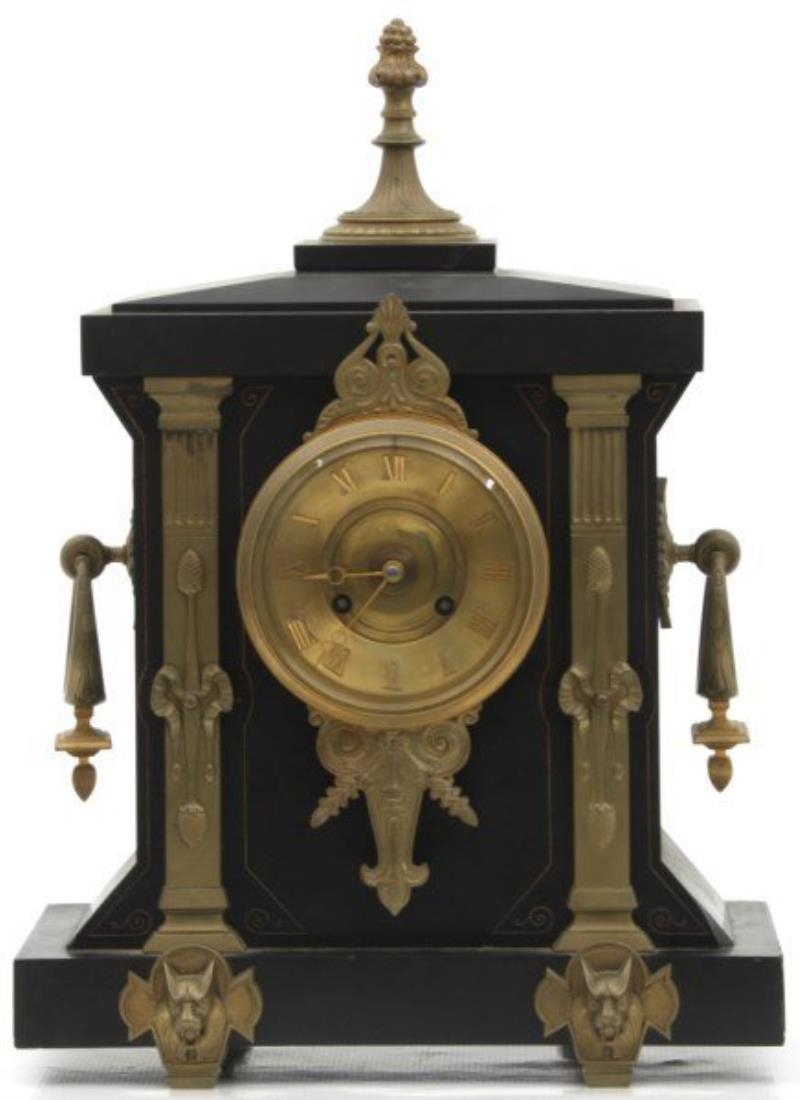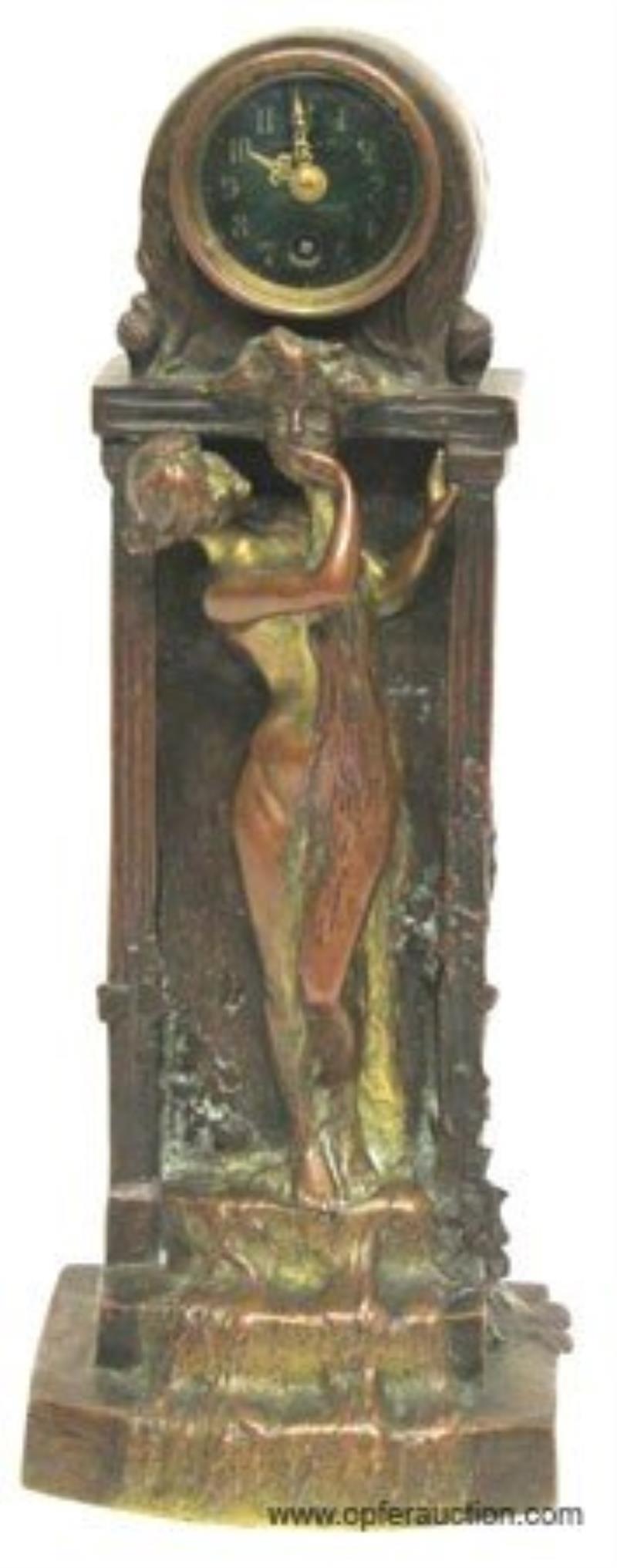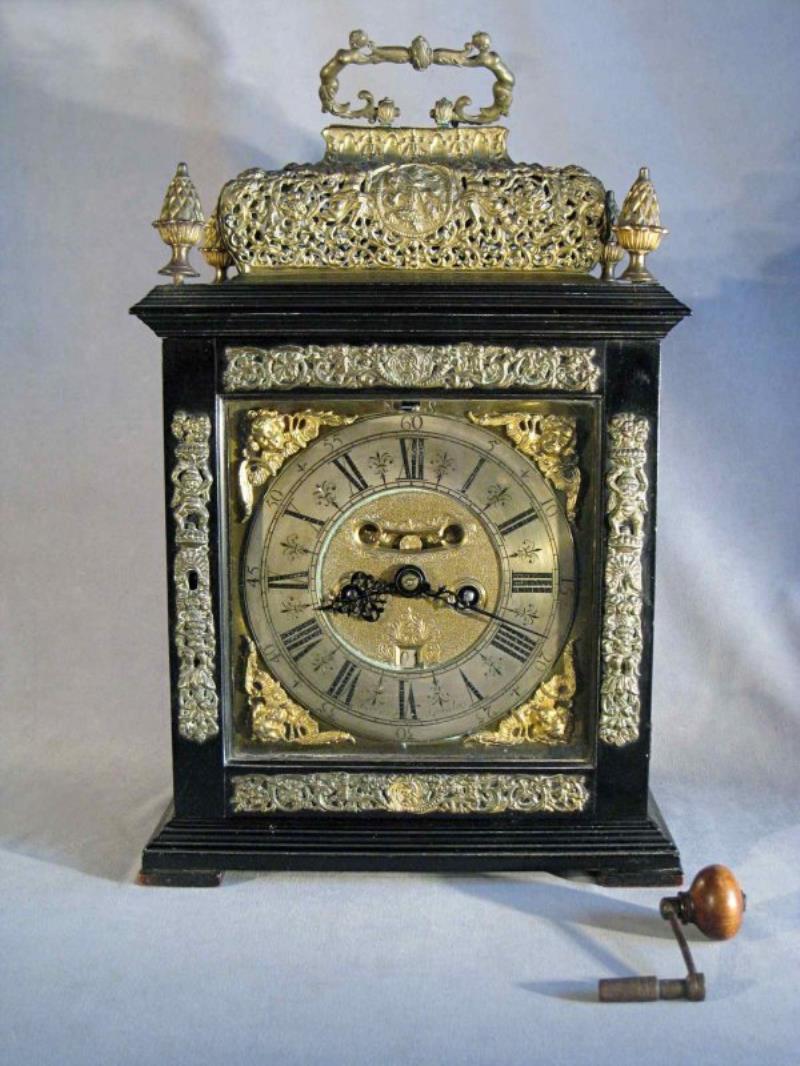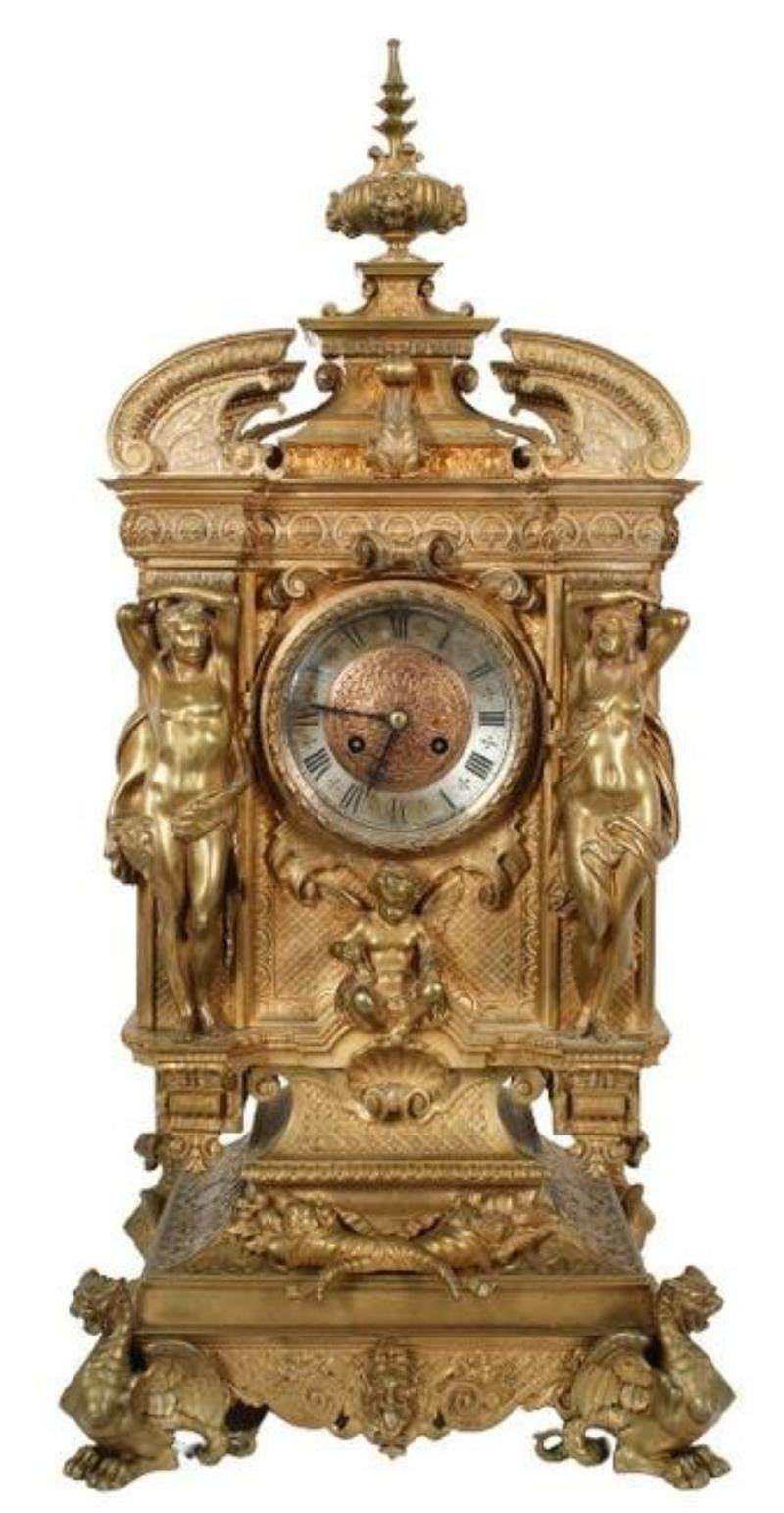Important Figural Bronze Tiffany & Co NY Clock
- Estimate:
- [restrict paid=ture]$5,000 – $7,000[/restrict]
- Auctioneer:
- [restrict paid=ture]Sarasota Estate Auction[/restrict]
- Sold Price:
- [restrict paid=ture]$5,500[/restrict]
- Sold Date:
- [restrict paid=ture]Dec 12, 2021, 2021[/restrict]
Late 19th C Important Figural Bronze Tiffany & Co NY Clock with ornate design, gilded nude male and female figures on each side, cherub figure in the center holding an hourglass. Elaborate Griffon/dragon feet. Key and Pendulum.Size: 28 x 12 x 11 in.
Tiffany & Co. Marble & Bronze Mantle Clock

- Estimate:
- [restrict paid=ture]$400 – $600[/restrict]
- Auctioneer:
- [restrict paid=ture]Fontaine's Auction Gallery[/restrict]
- Sold Price:
- [restrict paid=ture]$700[/restrict]
- Sold Date:
- [restrict paid=ture]8:00 AM – May 21, 2016[/restrict]
Tiffany & Co. Marble & Bronze Mantle Clock. 4.5 in. brass dial signed ÂTiffany & CompÂy with applied brass Roman hour numerals, brass open moon hands and brass door bezel with beveled crystal; typical round French brass 8 day spring driven movement signed ÂTiffany & Co., New York and ÂS. Marti & CieÂ, has an half hour strike on a bell. In a black marble case with bronze finial (missing bowl), bronze ring side handles, pilasters, bezel escutcheon and werewolf style feet. In excellent condition, minor corner chips to the marble, has pendulum, running. 18 in. high x 13 in. wide x 5.75 in. deep. Weight: 49 lbs.
Tiffany & Co. Bronze & Marble Mantel Clock

- Estimate:
- [restrict paid=ture]$400 – $600[/restrict]
- Auctioneer:
- [restrict paid=ture]Fontaine's Auction Gallery[/restrict]
- Sold Price:
- [restrict paid=ture]$250[/restrict]
- Sold Date:
- [restrict paid=ture]Oct 23, 2021[/restrict]
Tiffany & Co. Bronze & Marble Mantel Clock
late 19th century
the clock with a foliate crest, lion heads on each side and paw feet, 8-day French movement with bell strike, signed "Tiffany & Co., New York/Japy Freres, Paris"
13 1/2 x 8 1/2 x 9 1/2 inches
Tiffany & Co. Gilt Bronze & Rouge Marble Mantel Clock

- Estimate:
- [restrict paid=ture]$400 – $600[/restrict]
- Auctioneer:
- [restrict paid=ture]Fontaine's Auction Gallery[/restrict]
- Sold Price:
- [restrict paid=ture]$225[/restrict]
- Sold Date:
- [restrict paid=ture]Oct 23, 2021[/restrict]
Tiffany & Co. Gilt Bronze & Rouge Marble Mantel Clock
late 19th century
the case with four Corinthian columns and a relief panel of putti, 8-day time and strike movement with rack and snail striking, movement signed "Tiffany & Co., New York/Vincenti & Cie"
10 3/4 x 10 3/4 x 4 3/4 inches
TIFFANY & CO. BRONZE FIGURAL MANTLE CLOCK

- Estimate:
- [restrict paid=ture]$1,000 – $2,000[/restrict]
- Auctioneer:
- [restrict paid=ture]Richard Opfer Auctioneering, Inc.[/restrict]
- Sold Price:
- [restrict paid=ture]$1,700[/restrict]
- Sold Date:
- [restrict paid=ture]2:00 PM – Jun 30, 2011[/restrict]
Signed giulloche enamel dial; French platform escapement; movement signed L.S., case signed Korsehann Paris 07;
Condition
A HIGHLY IMPORTANT BRONZE INDUSTRIAL CLOCK made in 1906

- Estimate:
- [restrict paid=ture]£30,000 – £40,000[/restrict]
- Auctioneer:
- [restrict paid=ture]John Nicholson Auctioneers[/restrict]
- Sold Price:
- [restrict paid=ture]£34,000[/restrict]
- Sold Date:
- [restrict paid=ture]6:00 AM – Nov 08, 2013[/restrict]
A HIGHLY IMPORTANT BRONZE INDUSTRIAL CLOCK made in 1906 for the Paris-Lyon-Mediterranean Railway inauguration of The Simpton Orient Express. The locomotive with two figures of Mercury showing the way, MercuryÂs hand on the clock dial. (See ÂLa Pendule FrancaiseÂ, Henri-Gustave Lengellé Tardy 1969, p497) 21 inches high, 16 inches wide, 16 inches deep, on a marble top stand, the front with initials ÂPLMÂ, 48 inches high.
Important Bracket Clock by Markwick

- Estimate:
- [restrict paid=ture]$4,000 – $10,000[/restrict]
- Auctioneer:
- [restrict paid=ture]Converse Auctions[/restrict]
- Sold Price:
- [restrict paid=ture]$4,000[/restrict]
- Sold Date:
- [restrict paid=ture]1:00 PM – Jun 18, 2010[/restrict]
A late 17th or early 18th century bracket or table clock signed “Markwick, London”. The Markwick family is known as one of the earliest of LondonÂs clockmakers, with James Markwick being succeeded by James, presumably his son. The second James Markwick ascended into the Clockmakers Company of London in 1692, becoming a master in 1720, and it was he who sometimes signed his work as simply ÂMarkwick like this example. This clock is late 17th or early 18th century.
Since the first clocks needed hanging weights to run, they had the problem of not being portable. Certainly one of the major advances in clock making in the late 1600s was the development of coiled mainsprings to drive the clock, making it possible to greatly reduce the clock’s size and weight- making them portable. So these mainspring driven Âbracket or Âchamber or Âtable clocks were ordinarily carried from room to room throughout the day by the handles mounted on top. Table clocks would run even if placed on the slightly un-level surface of a table or the floor; the feature of a Ârepeat device (such as this example once had) would allow its insomniac owner to pull the clockÂs night cord on his clock on the floor near the bed to hear the hours rung out at night when it was too dark to see the dial.
The first bracket clocks appeared in the late 1600s and were considered rare even in their own time, being something only those only the wealthiest could afford. Throughout the 18th century style changes were made to the mechanisms, dials and cases giving antiquarians a chance to date them with confidence. In addition to the dial signature, this example features a number of style examples that allow us to confirm its early 18th century date and London, England origin: a square engraved dial with a Âfalse pendulum aperture; a highly decorated and engraved backplate; an ebonized oak case; the patterns of the blued steel hands; the gilded Âangel spandrels; and the Âbasket top feature, whose top is made from a pierced, chaste, and engraved bronze frame instead of wooden moldings.
A word on the term Âbasket topÂ. A basket top was a less than usual stylistic feature for bracket clocks confined to early 18th century examples. Our example has lost its gilded (gold) or silvered surface as have the repousse door mounts. The basket features a central St George trampling and spearing the dragon below him. The engraved back plate is of top quality with a pattern of flowing, flowering tulips, an influence of the Dutch whose clockmakers worked closely with their English partners during this period. The anchor escapement is an early conversion from the original crown wheel escapement; the four pineapple finials are later.
This early bracket clock comes to us with a provenance of having been through three generations without substantial restorations. It was purchased in the 1920s, and kept time in the offices of Industrialist Roy D. Chapin, Secretary of Commerce during the Hoover Administration. After that it was displayed in the library of the renowned Grosse Pointe Farms, Michigan. Its lack of restorations for three generations is something sophisticated collectors appreciate: most prefer acquiring items of art and antiquity in Âas found condition, an assurance that there are no hidden restorations.
 ClockPrices.Com
ClockPrices.Com



